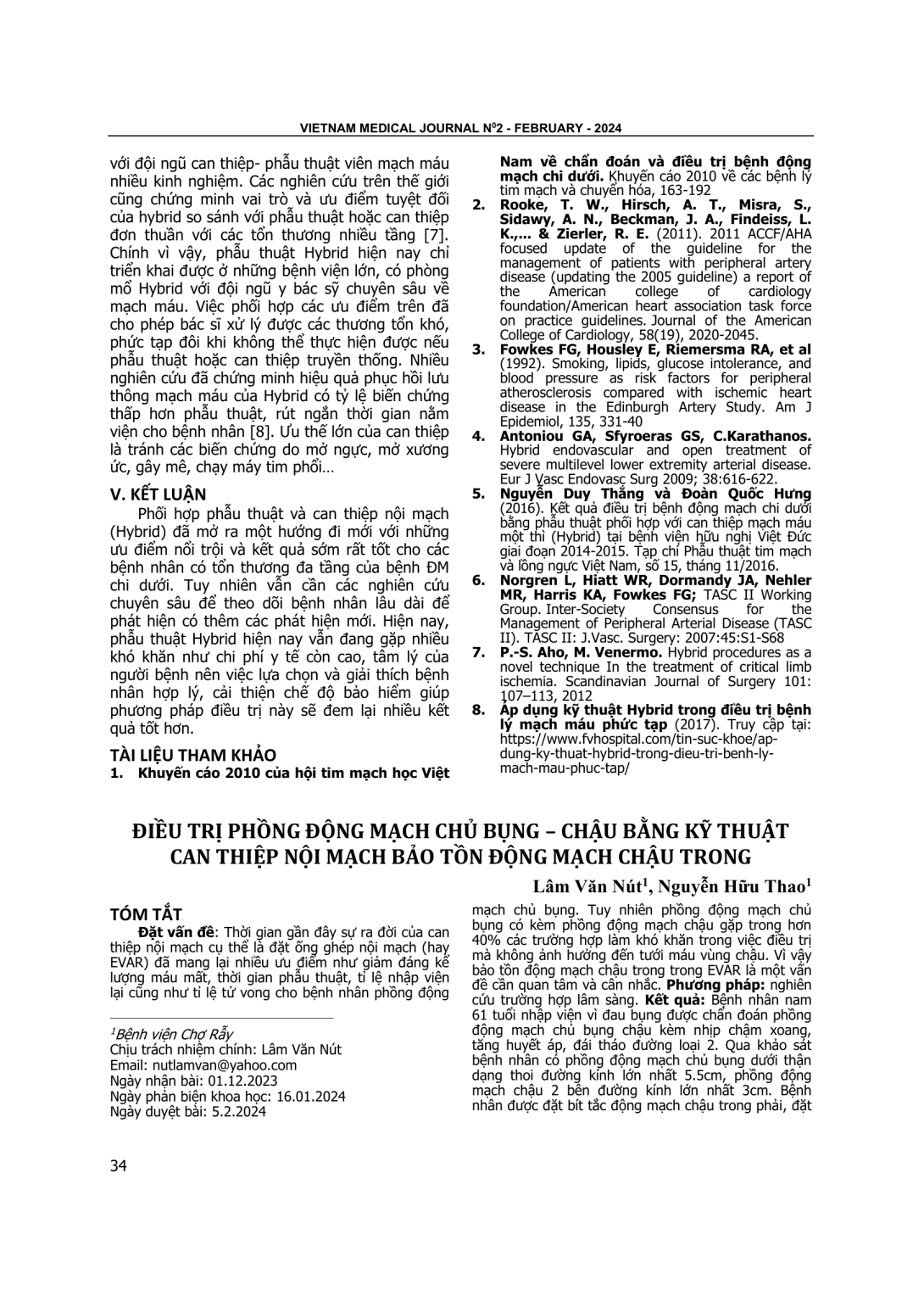
Thời gian gần đây sự ra đời của can thiệp nội mạch cụ thể là đặt ống ghép nội mạch (hay EVAR) đã mang lại nhiều ưu điểm như giảm đáng kể lượng máu mất, thời gian phẫu thuật, tỉ lệ nhập viện lại cũng như tỉ lệ tử vong cho bệnh nhân phồng động mạch chủ bụng. Tuy nhiên phồng động mạch chủ bụng có kèm phồng động mạch chậu gặp trong hơn 40% các trường hợp làm khó khăn trong việc điều trị mà không ảnh hưởng đến tưới máu vùng chậu. Vì vậy bảo tồn động mạch chậu trong trong EVAR là một vấn đề cần quan tâm và cân nhắc. Phương pháp: nghiên cứu trường hợp lâm sàng. Kết quả: Bệnh nhân nam 61 tuổi nhập viện vì đau bụng được chẩn đoán phồng động mạch chủ bụng chậu kèm nhịp chậm xoang, tăng huyết áp, đái tháo đường loại 2. Qua khảo sát bệnh nhân có phồng động mạch chủ bụng dưới thận dạng thoi đường kính lớn nhất 5.5cm, phồng động mạch chậu 2 bên đường kính lớn nhất 3cm. Bệnh nhân được đặt bít tắc động mạch chậu trong phải, đặt Stent graft có nhánh bảo tồn động mạch chậu trong trái. Sau mổ Stent graft thông tốt, động mạch chậu trong trái thông tốt, không có dấu hiệu rò, các chức năng ổn định và không có triệu chứng của thiếu máu vùng chậu. Bệnh nhân được xuất viện sau ba ngày, tái khám sau 1 tuần với các chỉ số ổn định và cải thiệu triệu chứng. Kết luận: Bảo tồn động mạch chậu trong lựa chọn tốt nhất để giảm nguy cơ thiếu máu vùng chậu. Tuy nhiên còn cân nhắc giữa nguy cơ và lợi ích cũng như tay nghề phẫu thuật viên hay điều kiện của trung tâm thực hành.
Recently, the development of specific endovascular interventions, such as endovascular aneurysm repair (EVAR), has brought many advantages such as significantly reducing blood loss, surgical time, rehospitalization rates, as well as mortality rates for patients with abdominal aortic aneurysms. However, abdominal aortic aneurysms accompanied by iliac artery aneurysms, which occur in over 40% of cases, can make treatment difficult without affecting blood supply to the pelvic area. Therefore, preserving the iliac artery in EVAR is an issue that needs attention and consideration. Methods: Case report. Results: A 61-year-old male patient was admitted to the hospital with abdominal pain and was diagnosed with abdominal aortic aneurysm with accompanying slow pulse, high blood pressure, and type 2 diabetes. Upon examination, the patient was found to have an infrarenal abdominal aortic aneurysm with a maximum diameter of 5.5 cm and bilateral iliac artery aneurysms with maximum diameters of 3 cm. The patient underwent right iliac artery occlusion and a stent graft was placed with a preserved left iliac artery branch. After the procedure, the stent graft was patent, the left iliac artery was open, there was no evidence of leakage, the functions were stable, and there were no symptoms of ischemia in the pelvic region. The patient was discharged after three days and re-evaluated after one week with stable indicators and improved symptoms. Conclusions: Preserving the internal iliac artery is the best option to reduce the risk of ischemia in the pelvic region. However, there should be a consideration between the risks and benefits as well as the skill of the surgeon and the conditions of the practice center.
- Đăng nhập để gửi ý kiến
